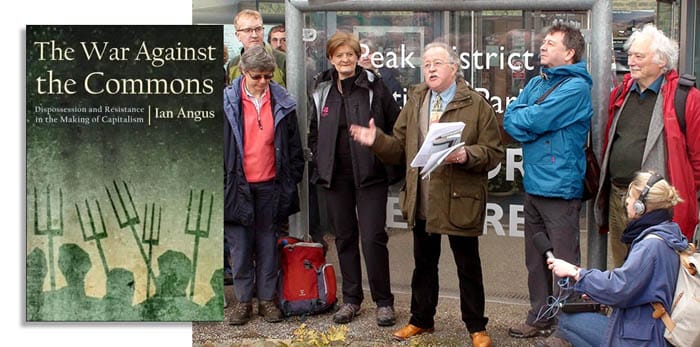
UK protestors mark the 80th anniversary of the 1932 mass trespass into privatized common land in the Peak District. (Morning Star)
Morning Star is a reader-owned socialist newspaper, published daily in London. This review appears in the September 3, 2023 issue.
THE COMMON CAUSE
Richard Murgatroyd welcomes the modern relevance of a history of the expropriation of common lands for private profit
A good history book makes you think about the present.
On the day I finished Ian Angus’s The War Against the Commons I visited my local station ticket office. The queue was long and I had time to look around and reflect. Once all this great building, this marvel of engineering, this vital service, had been publicly owned, part of the modern “commons.” Even now in its privatized state there remained some good elements – like the expert and helpful staff in the ticket office which the train-lords and rentier bankers were planning to evict!
So, Angus’s book is timely indeed.
For modern people brought up in a society where virtually all land is privately owned there are many surprises. At the time of the Norman conquest vast swathes of the land were held in common. While lords still claimed ownership and took a cut of the surplus food grown, their ability to exploit and control the people was therefore limited. Just about everyone relied on agriculture to survive and this was largely a collective endeavor, carried out on open fields divided among families according to rules and customs that had evolved over centuries.
An essential part of the economy was the “commons.” These lands were available to all and provided vital resources, like firewood, grazing for animals, wild berries and greens. Again, the people understood the need to manage them sustainably for the long term and were guided by mutually agreed customs.
Angus traces how medieval and modern elites successfully expropriated these common lands, enclosing them for their own profit. The focus is mainly on Britain, although the author takes care to put events in their proper international context. All this helps explain not only how capitalism developed here, but also why it has taken the particularly exploitative form we enjoy today.
For millions of people the seizure of the commons removed the possibility of a more independent life, however hard, and forced the people into a system of wage slavery. Out too went traditions that had sustained community life for millennia.
Naturally, the people resisted which helps explain why the enclosures took centuries, requiring a brutal combination of lawfare and warfare. Most revolts were reactive, like riots by “levellers” to pull down hedges, or armed demonstrations to warn off enclosing lords.
Some were incredibly forward thinking for the time. For example, Gerard Winstanley and the Diggers during the English Revolution of the 17th century understood that the land was ultimately our “common treasury” that should be owned and managed for the benefit of all.
But in the end the bosses won. Angus’s account raises some interesting questions about why this happened and what ordinary people could do differently today. He also addresses the debates around land ownership and arguments used to justify enclosure.
It has become an article of faith in capitalist economics that there is a “tragedy of the commons.” The argument goes like this: collective ownership of land inevitably leads to low productivity and environmental degradation as everyone scrabbles to get the maximum benefit from it, without a thought for the longer-term consequences. Therefore, only private ownership will ensure that it is fully productive and not over-exploited, as it is in the self-interest of the owners to do so. This capitalist farming feeds the millions in industrial cities that allows modern civilization to flourish.
Angus comprehensively demolishes the idea of a “tragedy of the commons” using rational argument and factual evidence. If he is right, then the implications for our own time and the growing environmental crisis are immense. If collective management of our “common treasury”, guided by mutual self-interest are indeed needed, then the whole question of who owns the land is back on the agenda.
So, this is a well-written book that is worth reading. The author allows the people of the time to speak for themselves wherever possible and keeps the narrative moving forward without over-simplifying a complicated story. We are getting plenty of “sweep” here, but plenty of interesting detail too. Ultimately the book succeeds because it embodies a powerful moral and social message that is still relevant today.
One anonymous 17th century poet quoted by Angus in his conclusion put it best of all: “The law locks up the man and woman/ Who steals the goose from off the common/ And geese will still a common lack/ Till they go and steal it back.”


